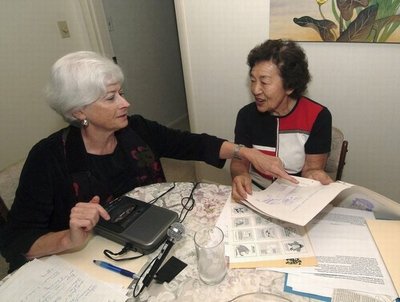December 1, 2005
A legacy uncovered: Education prof finds ‘treasure trove’ of teachers’ memories
Sometimes a research project evolves to become more than the sum of its parts. Even a small, fairly dry inquiry can bloom with context and meaning and begin unlocking larger truths — about who we are, or have been, or are becoming. Occasionally.
That’s what appears to be happening with Education Professor Nathalie Gehrke’s research studying cultural factors that can affect k-12 teachers of Japanese heritage. It might mean more work for Gehrke and others in time, but the 27-year teaching and research veteran couldn’t be happier, or more fascinated.
Gehrke’s is a small pilot project supported by $5,000 from the UW’s Institute for Ethnic Studies. Simply put, she set out to conduct oral histories of teachers of Asian descent to learn how their cultural background affected their teaching and classroom experience. She planned to interview members of various Asian populations, then quickly decided it best to follow a single trail and stuck with those with Japanese ancestry. With help from her doctoral assistant, Julie Kang, she identified several retired teachers and began scheduling interviews.
In the interviews, Gehrke watched and listened for certain information and cues: for cultural patterns and how they motivated teachers to teach; for relationships between the source of teaching styles and their ultimate reality in the classroom; and for how critical life incidents — especially related to race — shaped their ultimate personalities as teachers.
But when she started talking with these elders of the profession, the feeling changed, and what started as pure scientific inquiry grew more human, more meaningful.
Perhaps the idea is best understood by recounting Gehrke’s visit to Sharon Aburano of Bellevue, a former career grade school teacher and librarian, now 80-something and living in retirement. While a small tape machine whirred, Aburano told Gehrke of her many years teaching. Aburano papered the walls of her classroom with colorful cartoons and whatever she could find: “You have to ham it up better than television — you have to get their attention!” she said with a laugh.
She told of late nights correcting homework — “we worked all through the night, practically, and this is how prep time came into being” — and of arriving early to the classroom to put the day’s lesson on the chalk board. “Otherwise, if you waste your time putting things on the blackboard (during class), you’re going to lose the children.”
But as Aburano turned the pages from a huge scrapbook, other materials came into view. She had original, saved documents — notes, leaflets, government instructions, diaries — from her days in an Idaho internment camp to which Japanese-Americans were forced. There lay untouched paperwork from a poorly understood era, that, while still chillingly relevant, is ever fading from living memory.
What started as a story about cultural influences on teaching is growing into a collection of small but meaningful stories of human hope and courage during one of the darkest times in American and world history. What began as scholarly became human, warm-blooded, filled with the substance of the lives lived during that time.
Aburano, it turns out, was allowed to leave the internment camp after her high school graduation, as many young Asian women did, to study nursing in the Midwest through what was called the Cadet Nursing Program, a brochure for which also was in the scrapbook. She ultimately earned a nursing degree from the UW, but teaching remained her career ambition.
Gehrke also realized that the culture of that time included many things that have since returned heralded as new ideas or protocols as the decades moved by. Gehrke said she has long supported getting young teachers into support groups to share ideas and mentor each other, but is learning that such mentoring has been used before, if in slightly different form. “The reality was that those — I’ll call them almost grassroots improvement groups — have been going on a century or more among teachers, little valued or supported.
“What I recognized is that there is such a treasure trove here, it needs to be pursued,” Gehrke said. More than simple histories of young Japanese teachers are at the heart of this, she learned — the story of a time and place, and of how certain people survived, even flourished, against a backdrop of war and cultural misunderstanding.
Gehrke is still at work on her original research project. She has conducted seven interviews and is working up the transcripts. She hopes to present a paper on the project at the annual meeting of the American Education Research Association next spring. Publishing a paper in a journal on teacher education would likely be the next step, she said.
But Gehrke is also beginning to think there might be enough material for a larger work, to be done by her or someone else — an exploration, perhaps, of the young Japanese women who went from the internment camps to the classrooms of America in the 1950s.
Wherever the material leads her, or those who follow her, Gehrke said she has been delighted and energized by the process.
“I think I’ve done interesting and useful studies in my career, but here I am nearing the end of my career and I think this project may be the most important I have ever done,” she said. “I think it’s important and extraordinary and wonderful to be as enthusiastic now as I was about my early studies back in the 1970s.”
And if she decides to keep studying, she said, “It’s going to keep me busy until I’m 90.”



